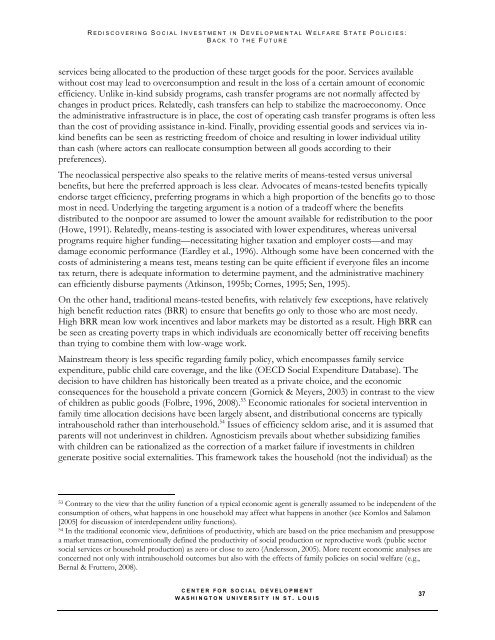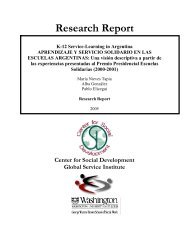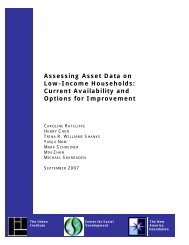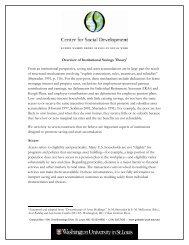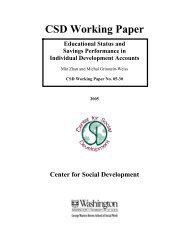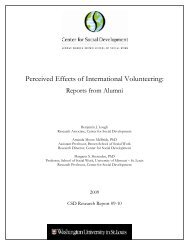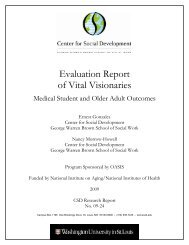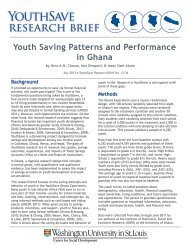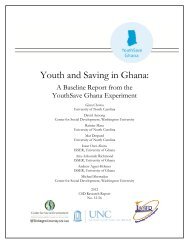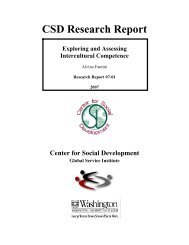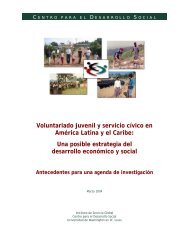Rediscovering social investment in developmental welfare state ...
Rediscovering social investment in developmental welfare state ...
Rediscovering social investment in developmental welfare state ...
Create successful ePaper yourself
Turn your PDF publications into a flip-book with our unique Google optimized e-Paper software.
R E D I S C O V E R I N G S O C I A L I N V E S T M E N T I N D E V E L O P M E N T A L W E L F A R E S T A T E P O L I C I E S :<br />
B A C K T O T H E F U T U R E<br />
services be<strong>in</strong>g allocated to the production of these target goods for the poor. Services available<br />
without cost may lead to overconsumption and result <strong>in</strong> the loss of a certa<strong>in</strong> amount of economic<br />
efficiency. Unlike <strong>in</strong>-k<strong>in</strong>d subsidy programs, cash transfer programs are not normally affected by<br />
changes <strong>in</strong> product prices. Relatedly, cash transfers can help to stabilize the macroeconomy. Once<br />
the adm<strong>in</strong>istrative <strong>in</strong>frastructure is <strong>in</strong> place, the cost of operat<strong>in</strong>g cash transfer programs is often less<br />
than the cost of provid<strong>in</strong>g assistance <strong>in</strong>-k<strong>in</strong>d. F<strong>in</strong>ally, provid<strong>in</strong>g essential goods and services via <strong>in</strong>k<strong>in</strong>d<br />
benefits can be seen as restrict<strong>in</strong>g freedom of choice and result<strong>in</strong>g <strong>in</strong> lower <strong>in</strong>dividual utility<br />
than cash (where actors can reallocate consumption between all goods accord<strong>in</strong>g to their<br />
preferences).<br />
The neoclassical perspective also speaks to the relative merits of means-tested versus universal<br />
benefits, but here the preferred approach is less clear. Advocates of means-tested benefits typically<br />
endorse target efficiency, preferr<strong>in</strong>g programs <strong>in</strong> which a high proportion of the benefits go to those<br />
most <strong>in</strong> need. Underly<strong>in</strong>g the target<strong>in</strong>g argument is a notion of a tradeoff where the benefits<br />
distributed to the nonpoor are assumed to lower the amount available for redistribution to the poor<br />
(Howe, 1991). Relatedly, means-test<strong>in</strong>g is associated with lower expenditures, whereas universal<br />
programs require higher fund<strong>in</strong>g—necessitat<strong>in</strong>g higher taxation and employer costs—and may<br />
damage economic performance (Eardley et al., 1996). Although some have been concerned with the<br />
costs of adm<strong>in</strong>ister<strong>in</strong>g a means test, means test<strong>in</strong>g can be quite efficient if everyone files an <strong>in</strong>come<br />
tax return, there is adequate <strong>in</strong>formation to determ<strong>in</strong>e payment, and the adm<strong>in</strong>istrative mach<strong>in</strong>ery<br />
can efficiently disburse payments (Atk<strong>in</strong>son, 1995b; Cornes, 1995; Sen, 1995).<br />
On the other hand, traditional means-tested benefits, with relatively few exceptions, have relatively<br />
high benefit reduction rates (BRR) to ensure that benefits go only to those who are most needy.<br />
High BRR mean low work <strong>in</strong>centives and labor markets may be distorted as a result. High BRR can<br />
be seen as creat<strong>in</strong>g poverty traps <strong>in</strong> which <strong>in</strong>dividuals are economically better off receiv<strong>in</strong>g benefits<br />
than try<strong>in</strong>g to comb<strong>in</strong>e them with low-wage work.<br />
Ma<strong>in</strong>stream theory is less specific regard<strong>in</strong>g family policy, which encompasses family service<br />
expenditure, public child care coverage, and the like (OECD Social Expenditure Database). The<br />
decision to have children has historically been treated as a private choice, and the economic<br />
consequences for the household a private concern (Gornick & Meyers, 2003) <strong>in</strong> contrast to the view<br />
of children as public goods (Folbre, 1996, 2008). 53 Economic rationales for societal <strong>in</strong>tervention <strong>in</strong><br />
family time allocation decisions have been largely absent, and distributional concerns are typically<br />
<strong>in</strong>trahousehold rather than <strong>in</strong>terhousehold. 54 Issues of efficiency seldom arise, and it is assumed that<br />
parents will not under<strong>in</strong>vest <strong>in</strong> children. Agnosticism prevails about whether subsidiz<strong>in</strong>g families<br />
with children can be rationalized as the correction of a market failure if <strong><strong>in</strong>vestment</strong>s <strong>in</strong> children<br />
generate positive <strong>social</strong> externalities. This framework takes the household (not the <strong>in</strong>dividual) as the<br />
53 Contrary to the view that the utility function of a typical economic agent is generally assumed to be <strong>in</strong>dependent of the<br />
consumption of others, what happens <strong>in</strong> one household may affect what happens <strong>in</strong> another (see Komlos and Salamon<br />
[2005] for discussion of <strong>in</strong>terdependent utility functions).<br />
54 In the traditional economic view, def<strong>in</strong>itions of productivity, which are based on the price mechanism and presuppose<br />
a market transaction, conventionally def<strong>in</strong>ed the productivity of <strong>social</strong> production or reproductive work (public sector<br />
<strong>social</strong> services or household production) as zero or close to zero (Andersson, 2005). More recent economic analyses are<br />
concerned not only with <strong>in</strong>trahousehold outcomes but also with the effects of family policies on <strong>social</strong> <strong>welfare</strong> (e.g.,<br />
Bernal & Fruttero, 2008).<br />
C E N T E R F O R S O C I A L D E V E L O P M E N T<br />
W A S H I N G T O N U N I V E R S I T Y I N S T . L O U I S<br />
37


